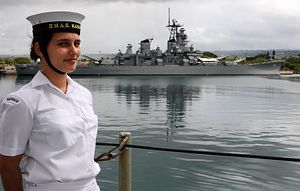Australia’s defense spending will increase from A$32.4 (US$23.07) billion in fiscal year 2016-17 to A$58.7 (US$41.08) billion in 2025-26, according to the new 2016 Defense White Paper released by the Australian Department of Defense this week. That’s an 81 percent jump in expenditure over the next decade.
Under this new budget model, defense spending is slated to grow to A$42.4 (US$30.42) billion by 2020-21, reaching two percent of Australia’s GDP based on current projections. Overall spending in the next ten years for “investment in new and enhanced capabilities” will add up to A$195 (US$140) billion.
Interestingly, military funding will be decoupled from GDP growth, meaning that there will be no reduction in defense spending even if Australia’s economy contracts. “This de-coupling from GDP forecasts will avoid the need to have to regularly adjust Defense’s force structure plans in response to fluctuations in Australia’s GDP,” the paper notes.
One quarter of the A$195 billion will be dedicated to expanding the capabilities of the Royal Australian Navy (RAN), which the paper describes as “the most comprehensive regeneration of our Navy since the Second World War.”
The RAN will procure a new fleet of submarines based on a “rolling acquisition program:”
The acquisition of the 12 future submarines will commence in 2016 with the first submarines likely to begin entering service in the early 2030s. Construction of the 12 new submarines will extend into the late 2040s to 2050 timeframe.
The design and construction of this new fleet will cost at least A$50 billion and constitutes “the largest defense procurement program in Australia’s history,” the white paper notes. The cost estimate does not include sustainment of the new submarines.
The surface fleet will also increase substantially, including three Hobart-class Air Warfare Destroyers to enter into service in the early 2020s, nine new future frigates optimized for anti-submarine warfare, and 12 new offshore patrol vessels, in addition to life-extension programs of four mine hunting ships.
“Eight P-8A Poseidon maritime surveillance and response aircraft will be introduced in the early 2020s,” the white paper states, in addition to seven MQ-4C Triton unmanned aerial vehicles. The RAN is also in the process of introducing 24 MH-60R Seahawk naval combat helicopters in order to enhance its anti-ship and anti-submarine warfare capabilities.
Additionally, money will be spent on new land-based anti-ship missiles. “We are a maritime power,” Australia’s Prime Minister Malcom Turnbull said in Canberra this Thursday on the occasion of the white paper’s release. “An island nation needs a strong navy. It particularly needs a strong navy in this environment.”
Nine percent of the money will be spend on increasing intelligence, surveillance, reconnaissance, space, electronic warfare, and cyber capabilities. Eighteen percent will be allocated toward land combat and amphibious warfare upgrades, while 17 percent will be invested into strengthening strike and air combat power.
In addition, six percent is dedicated to air and sea lift capabilities and 25 percent of the A$195 billion will be spent on “key enablers” including upgrades to bases, airfields, and naval ports. The overall size of Australia’s defense force of 62,400 is slated to increase by 2,500 over the next decade.
































